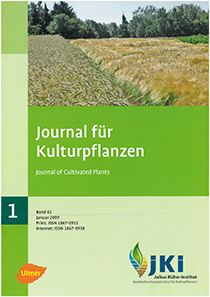Minimizing ergot infection in hybrid rye by a SMART breeding approach
DOI:
https://doi.org/10.5073/JfK.2009.01.03Keywords:
Secale cereale, hybrid breeding, Claviceps purpurea, molecular markers, cms, restorerAbstract
The restorer gene Rfp1 results in an almost complete restoration of male fertility in hybrid rye varieties and, thus, contributes to minimize harvest contamination with ergot. Here, we report on the validation of recently established Rfp1 markers located on chromosome 4RL in elite breeding lines of rye. The Rfp1 genotypes, as deduced by molecular-marker analysis, perfectly corresponded with the degree of male fertility assessed in test crosses of individual genotpes with male sterile testers. Recombination could be observed between Rfp1 markers indicating their potential to reduce the donor chromosome segment carrying Rfp1. These marker alleles proved to be diagnostic for Rfp1 in current breeding lines. Taken together, results presented qualify the novel markers as efficent molecular tools to assess the restorer gene Rfp1 in elite breeding lines of rye. In addition, we have observed linkage of the Rfp1 markers to the restorer gene Rfc1. Thus, the validated markers should be applicable for marker-assisted selection strategies of maintainer genotypes of the male sterility inducing C cytoplasm, which occur at low frequency in European rye populations as well. The observed linkage of the STS markers to both Rfp1 and Rfc1 supports the assumption that the restorer genes identified on chromosome 4RL are either alleles of a single restorer gene or represent different linked genes located in this sub-genomic region.
Downloads
Published
Issue
Section
License
The content of the journal is licensed under the Creative Commons Attribution 4.0 License. Any user is free to share and adapt (remix, transform, build upon) the content as long as the original publication is attributed (authors, title, year, journal, issue, pages).
The copyright of the published work remains with the authors. The authors grant the Journal of Cultivated Plants, the Julius Kühn-Institut and the OpenAgrar repository the non-exclusive right to distribute and exploit the work.







